In a course that I was taking as part of my Master’s program that provided an introduction to game-based teaching, I had the chance to learn about the benefits of adopting curricular games when developing a learning experience. As an instructional designer who has seen the impact of games on people and their ability to teach life skills, I will share with you five reasons why I see game-based teaching (GBT) as a winning approach when it comes to developing learning experiences in the 21st century.
“Games aren’t just filler in education. They have the ability to introduce, reinforce, or even assess learning of a given topic”
Kara Carrero
- Engaging and Entertaining Experience:
None of us would be happy to see our students distracted from what we are teaching, therefore, we put a lot of effort into ensuring that we keep the learners engaged. Curricular games are a great technique to do so! Let us think of a time when you played a game such as Monopoly or Grand-Theft Auto or any game you loved, do you remember how you felt? Can you think of skills you learned through these games? Did you feel bored? If you are like me, most probably you were engaged in a flow state that you didn’t even feel the hours passing by when playing, and possibly you learned various skills such as coordination, decision making, critical thinking, and time management. Well-designed games can be a great entertainment and learning tool, not only to transfer knowledge but also to develop soft skills that are required in the employment world today.
2. Risk Without the Consequences:
Teaching through games encourages learners to make hard decisions and take risks that they might not be able to do in real life. This is due to the ability of games to simulate real-life events and situations without actually having real consequences. The player who is the learner will be more comfortable taking steps or actions that they might avoid in real life only because they are afraid of the result this decision can bring. For instance, in a soccer video game, the player might try a new playing mechanism or strategy without being afraid of losing a point because they know that the loss will only be in the game and not in real life.
3. From the Game to Reality:
Since games are built on real-life situations and events, the player with proper design and direction from the teacher, trainer, or the game itself will see the connection between the curricular game and real-life situations. In such conditions, the player or learner tends to find it easier to develop the connections between the game world and the real world, thus the learner will be able to apply the skills they learned in the game in real-life situations. For example, going back to the game Monopoly players can take the investment skills and strategies they learned while playing the game and apply them to real-life conditions.
4. Special Ed and ELL Students are Welcomed:
Game-based teaching can be a good choice for the educator who teaches English language or special education learners as it provides scaffolding based on the learner’s needs and offers customized directions and challenges. GBT also encourages collaborative learning which is an effective learning approach when teaching ELL and Special Ed students. Collaboration in games takes place during playing among teams or with other players. If you are a teacher focusing on ELL or special Ed students check the experience of Maile Hoyt, a special education teacher in Texas, when using games for teaching her students. Additionally, game-based learning aligns with the universal design learning (UDL) framework making it a great choice for classrooms with students who have different needs.
5. Roots in Learning Theories:
What I also like about game-based teaching and using curricular games to develop a unique learning experience is that GBT has roots in various well know learning theories. Among these theories come the zone of proximal development (ZPD) and Vygotsky’s scaffolding theories, just-in-time instructions, experiential learning, and social cognitive learning. The discussion about the roots of GBT in dominating learning theories needs a separate post, but might encourage you to look into it and is key if you need to convince your institute, parents, or students about the effectiveness of GBT.
Let’s make this short, if you are an educator and looking for a technique that would bring life to your classroom or the learning experiences you develop, I encourage you to look more into curricular games design and game-based teaching. And if you are already using this technique I would love to hear your experience.
]]>Why did I do so? Merely because if I wanted to learn, I had to start with a new slate. This was necessary for me to be able to absorb new information without it being filtered through the layers of knowledge and experience I have built over the years, I wanted to marginalize constructivism learning theory at this stage if that is possible. Let me share an example of the importance of this phase, in business we use the term SMEs to refer to small and medium-sized enterprises, while in instructional design we use it to refer to subject matter experts. It’s as simple and confusing as that! The good thing with coming from a different background is that I don’t have to unlearn things in the field itself that I might have learned incorrectly, instead I am starting a new page and getting the proper knowledge on it.
“If I wanted to learn, I had to start with a new slate“
Now after a year in the program and taking seven courses so far, I have come along way, currently, I wear both lenses the business one and the instructional design one, I am happy with the outcomes because learning is part of everything and business as well. I find that both fields complement each other for me. I use business skills such as communication, project management, budgeting, and planning in my instructional design work, and vice versa!
My interest and experience in entrepreneurship are reflected in my choices of projects and topics to work on in my instructional design program. I have a goal of building an open-source learning material for business owners to help them with developing the skills they need to manage their business. This might sound ambitious but it is not impossible.
Yes, I have taken a shift, but I did not press delete! I still use my previous knowledge and experience to develop my unique take on both worlds.
Have you shifted from a completely different field to instructional design? would love to hear about your experience.
Featured image by Sayed Ali on Unsplash
]]>After doing extensive research, reading, completing a couple of MOOCs, and social learning I realized that I tapped into a grey area. At first, I thought it all made sense until I realized that instructional design and user experience design are two different fields that seem to have little awareness of each other. Generally, the different opinions I have observed brought me to two streams of thoughts, first, the concept of learning experience design, and second that user experience design will take over instructional design. I found the two notions are not completely true, mainly because they look at one side of the equation, but before I continue with my findings let’s look into the most important terms that I will come across in this post.
Instructional Design (ID)
According to the Association of Talent Development, instructional design is the creation of learning experiences and materials in a manner that results in the acquisition and application of knowledge and skills. The discipline follows a system of assessing needs, determining learning objectives, developing materials, and evaluating their effectiveness.
Learning Experience Design (LXD)
LXD.org defines Learning experience design as the process of creating learning experiences that enable the learner to achieve the desired learning outcome in a human-centered and goal-oriented way. In LXD the focus in on the learner and the process that the learner goes through.
User Experience Design (UXD)
The Nielsen Norman Group co-founded by professor and author Don Norman states that User experience encompasses all aspects of the end-user’s interaction with the company, its services, and its products. User experience design is the process of supporting user behavior through usability, usefulness, and desirability provided in the interaction with a product. UX designers employ design thinking processes to reconcile user’s needs with technical feasibility and business viability.
User Interface Design (UI)
Interaction Design Foundation defines user interface design as the process designers use to build interfaces in software or computerized devices, focusing on looks or style, UI design refers to graphical user interfaces and other forms—e.g., voice-controlled interfaces.
ID vs. LXD
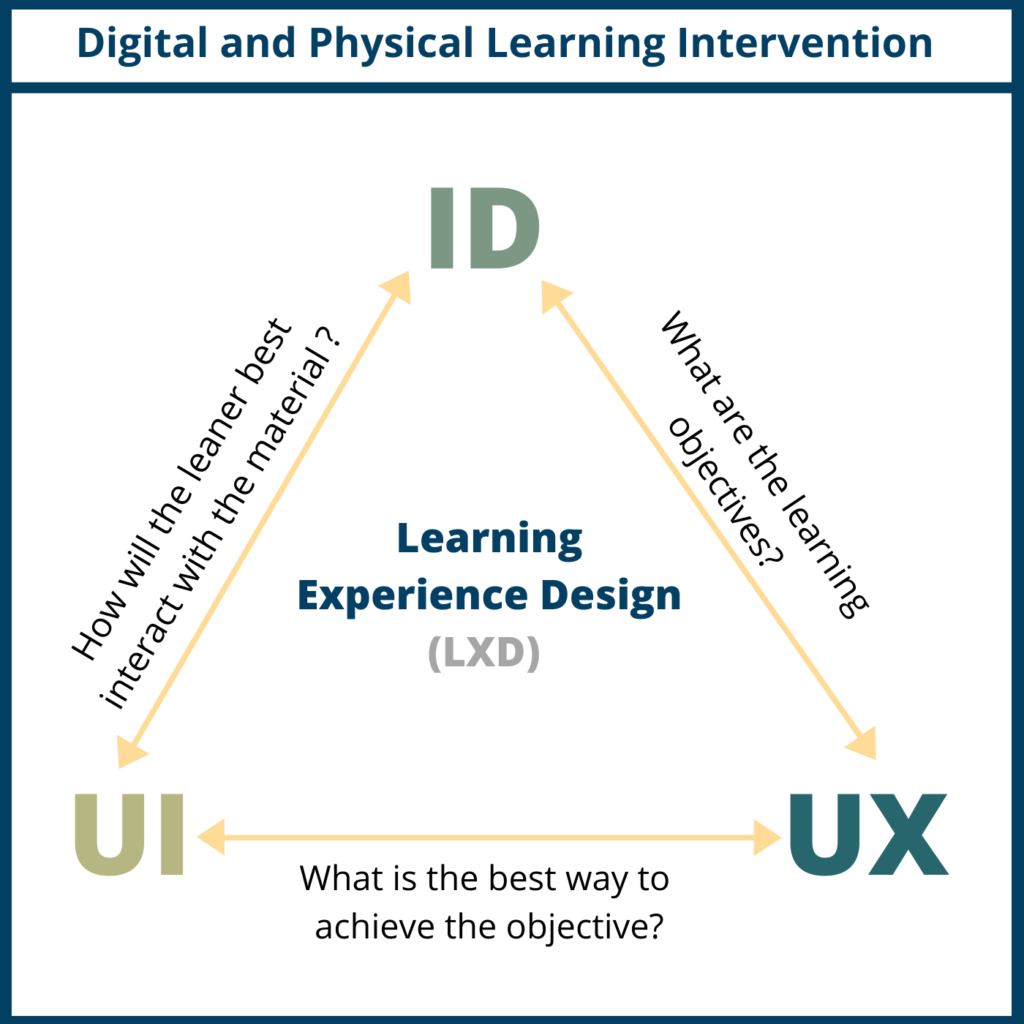
Exploring the relationship between ID and UXD most of the time led me to the concept of learning experience design (LXD). Supporters of this opinion made it as simple as ID + UX=LXD. The difference they made between ID and LXD is that instructional design focused on the instructions and instructor, while learning experience design focused on the learning and the learning process. I disagree with this opinion, it cannot be as simple as this equation is showing, because ID is broader than is claimed. Instructional design puts the learner as the center of the process. It analysis learners, their context, needs, and then uses the best pedagogical practices to deliver the learning. An opinion that I support, is that Learning experience design is the new name of instructional design because it fairly represents the work done by instructional designers and makes it easier for others to immediately understand what instructional designers do. However, using UX and UI design principles in addition to ID to develop training material will result in a rich learning experience outcome.
ID vs. UXD
Some of the opinions that I came across during my research is that UXD will take over instructional design because it is more user-centered, and that is what eLearning needs. Though using UX guidelines for designing learning material especially eLearning is very beneficial and adds great value to instructional designers, I still do not think that user experience designers will be able to replace instructional designers, mainly because UX designers do not have a pedagogical experience. Learning is not about usership only, it is about knowledge transfer using effective learning theories and tools.
Looking at both processes of ID and UX we can find many similarities. They both involve analysis of user or learner, aim to develop an effective and user-friendly experience, and achieve the set goal.
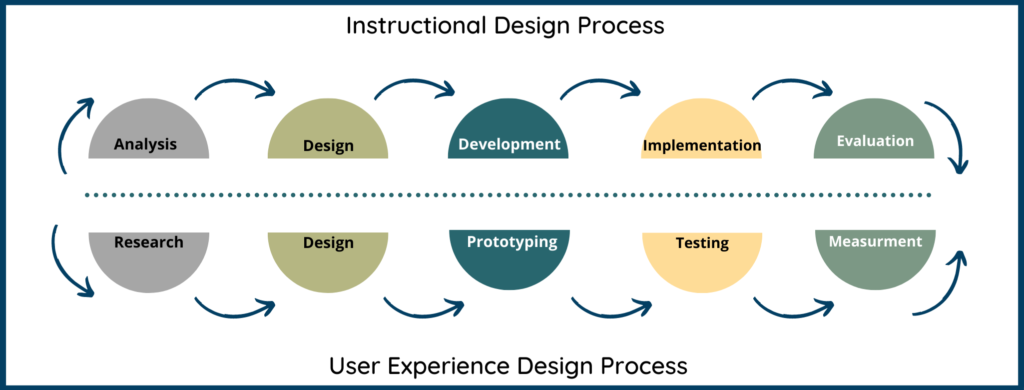
Roles Comparison
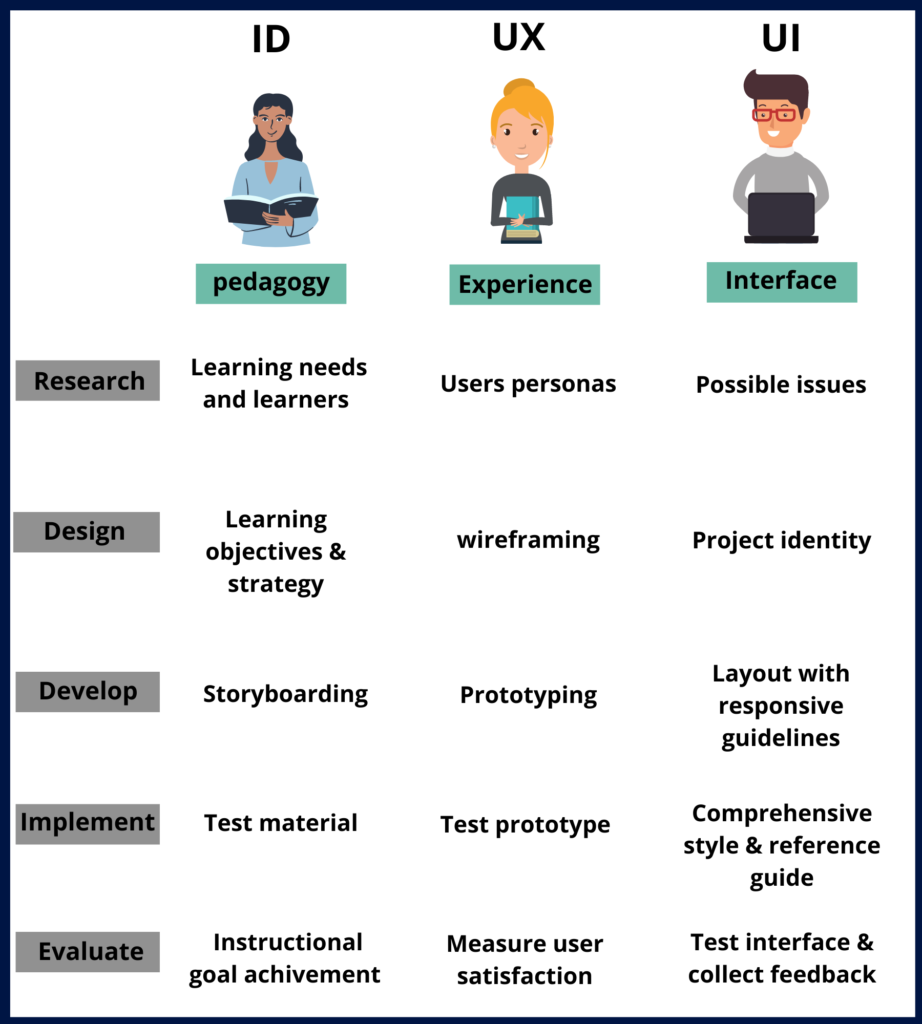
ID and UI
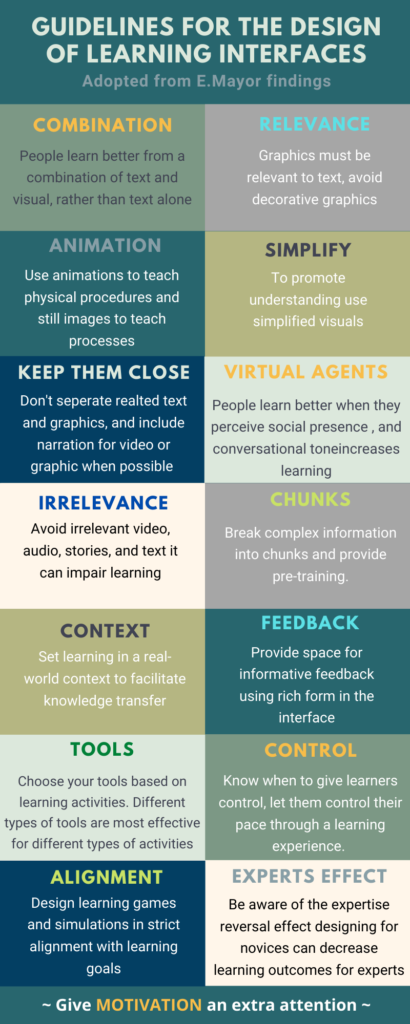
The relationship between Instructional design and user interface design is derived from the ability to use interface design principles to eLearning material or physical training material as well. User interface design is applied on the interface the user interacts with, for example in an eLearning training UI design principle applies to navigation buttons, font, white space. Typography, images, video, text are an example of a physical material that can make use of UI principles. What UI principles can add to ID is providing useful guidelines and tips for designing learning assets such as videos, info-graphic, and eLearning modules interface.
How do they work together?
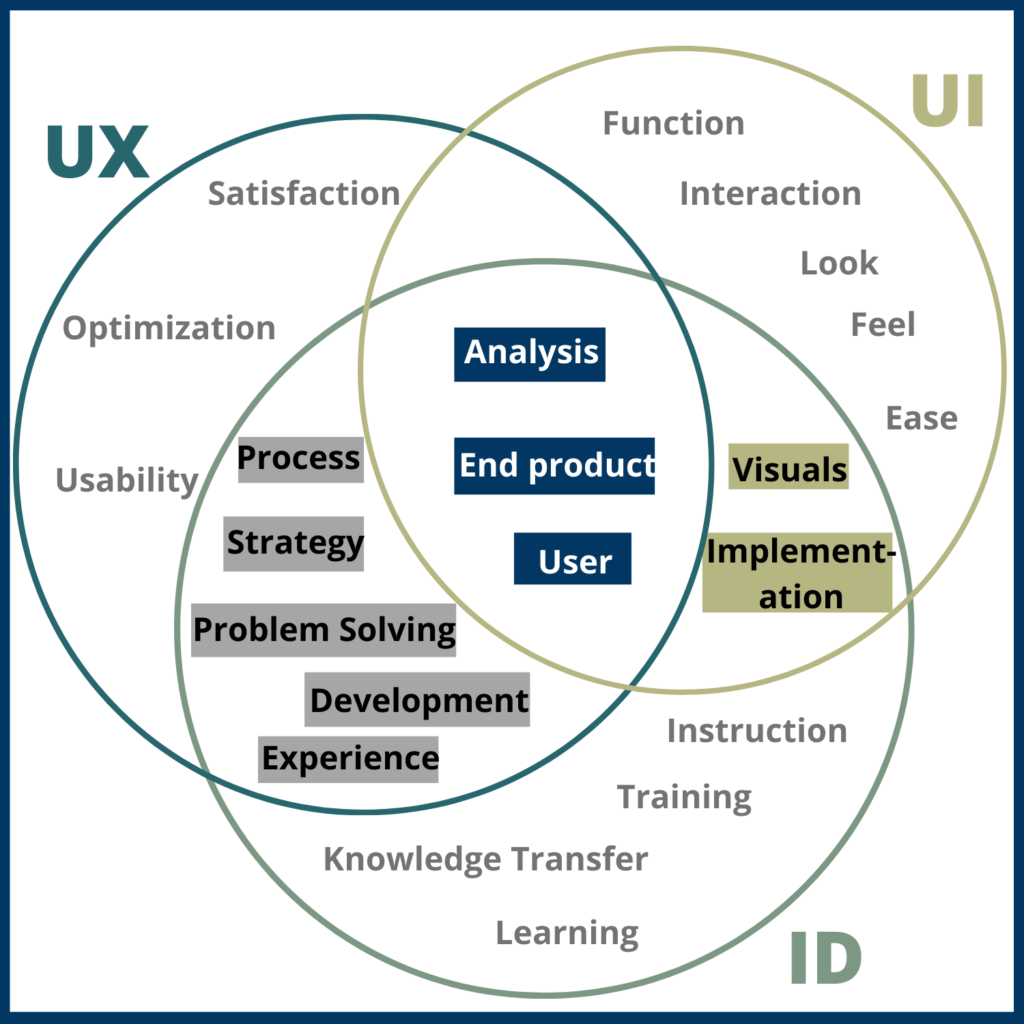
Applying UX and UI principles in ID is very beneficial for the outcome, it will result in a better experience in general when putting all into consideration. However, due to the similarities between UX and ID, there might be minor additions when the instructional designer is working on the full instructional design process. The ability to fully apply the principles can be impacted by the size of the team, if an instructional designer is individually working on a learning experience, they might not be able to fully accommodate all UX and UI principles, and following ID or LXD principles will make them end with a good learning experience; however, if working within a big team to design, then having a UX designer and UI designer on board can be of a great added value.
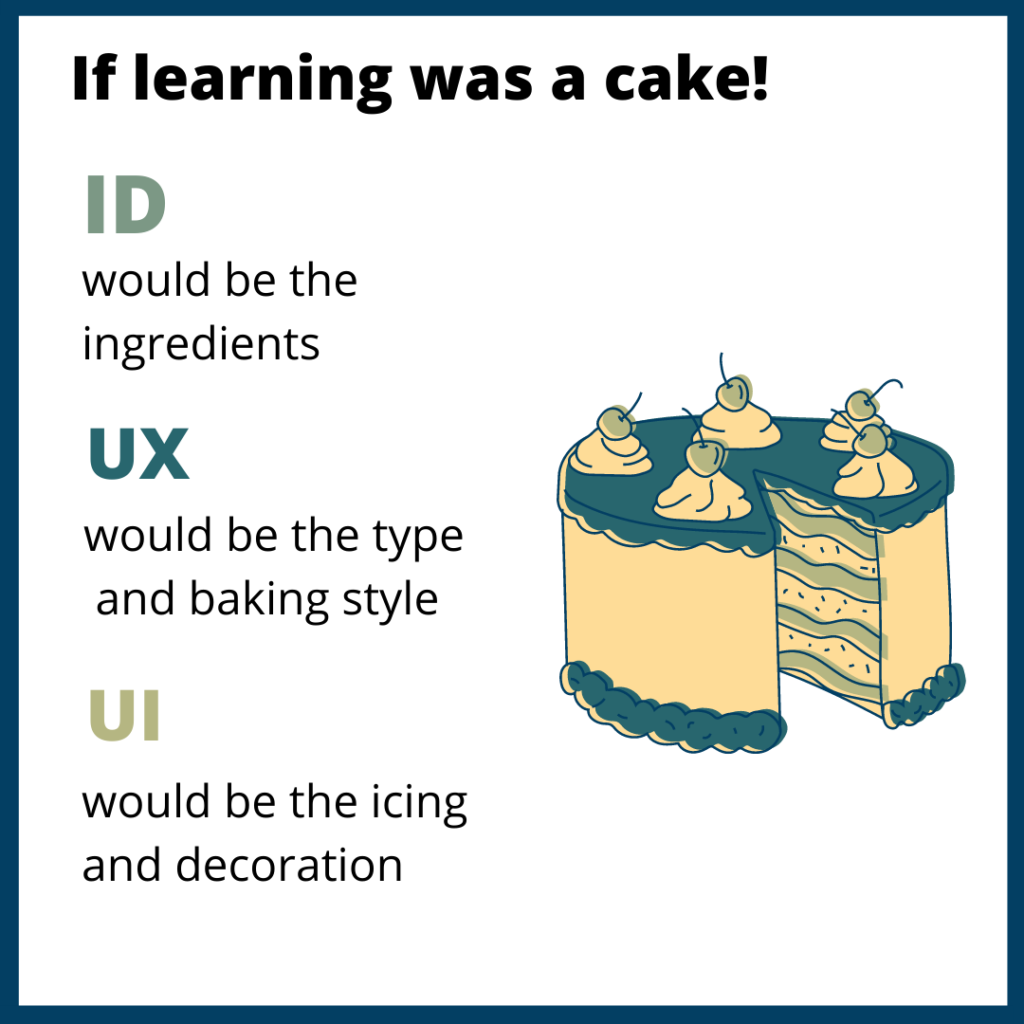
At the end of my research I found out that there are a lot of similarities between UX and ID, but each is being applied in a different field. UX and UI design complement instructional design in producing an efficient, eye-pleasing, and user-friendly learning experiences. I like to use the cake analogy, it gives it some sense.
This was my takeout on the association between ID, UXD, and UI design; would love to hear a different point of view from you on this matter.
Featured image by UX Indonesia on Unsplash
]]>Small businesses and startups are other environments were employees’ training and development are overlooked, which can be understandable. However, what these businesses need to keep in mind is that employment market can be competitive, and small businesses don’t always provide a sense of job security so a lot of times they end up with less skilled employees because they are not able to compete with bigger companies who have higher salary scale, development programs for their staff, a stronger name to add to their resume, and a well-established hierarchy that gives them a sense of safety.
An article by Monster.com talks about employees retention and lists employees not given developmental opportunities among the reasons they quit their jobs. From my managerial experience, employees are encouraged to stay in a company that invests in their development by providing training and growth opportunities. Therefore, small businesses need solutions to how they can provide such an environment for their employees while maintaining a reasonable budget.
A great solution is micro-learning based training. Though micro-learning does not have a universal definition, I will refer to a simple definition by Karla Gutierrez, as she defines it as an educational approach that offers bite-sized, small learning units with just the necessary amount of information to help learners achieve a goal. Just like how bite-sized food have the full flavor, taste, and experience of the same full-sized dish, and gives the person a chance to try different varieties of flavors while being easy on the stomach; micro-learning let you learn what you need in a shorter time, giving the learner a chance to learn several things quicker while engaging in a full learning experience that is more digestible for the brain.
Why micro-learning can be a solution for your small business or tight budget?
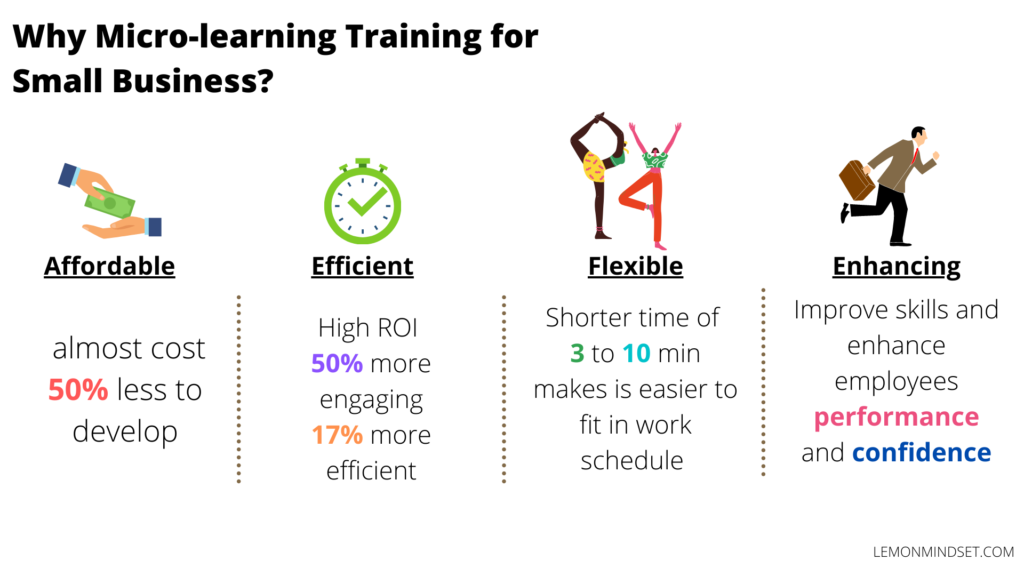
1- Affordable:
Developing micro-learning training material can cost almost 50% less than conventional learning programs, generally because they are shorter and take less time to develop. Also, most of the time micro-learning does not need an instructor, training space, or equipment, as they are self-directed eLearning experiences at most. Some platforms such as Youtube and Wikihow provide free material as well, all you need is to give your employees the time and encouragement to engage with micro-learning.
2- Cost and time efficient:
Micro-learning has a high return on investment (ROI) because they are highly effective compared to what they cost. Studies show that with micro-learning the transfer of learning is around 17% more efficient and the learning experience is 50% more engaging, resulting in better retention of learned knowledge. Therefore the amount of money spent on employees’ micro-learning training considered well invested.
3- Flexible:
Micro-training gives the employees the flexibility of accommodating them in their busy working schedule, without them being away from their office or daily responsibilities for a long time. This made possible by the bite-sized nature of the materials used that average between 3 to 10 minutes and can be easily accessed from any mobile device. This is crucial for small businesses that operate with a small number of employees.
4- Enhances employees’ performance:
Many businesses work hard to have highly skilled employees, as it provides them with a competitive advantage. Unfortunately, small businesses can’t afford to have an employee for every specific role in the business, therefore, they tend to have an employee performing more than one task. However, it is not easy to find one employee who is a high performer at all tasks. Micro-learning can help business owners in developing specific skills that their business needs because they are focused and learner-centered. Micro-learning works well in providing learners with the precise needed skill and know-how, leaving them feeling more empowered and confidant.
If you think that micro-learning is a solution for your small business, I am curious know what are the most required skills for your employees and why?
Featured Image by Miguel Andrade on Unsplash
]]>Answering this question is not very simple! Culture adds depth and complexity to any experience, and learning is an experience after all. I would start with how the teacher is perceived, where I come from the teacher plays the role of the sage on the stage, students look at the teacher as the trusted source of knowledge leaving little space for evaluating the new information, or speaking up their own opinion if it was different. This brings us to the most popular used teaching style which is the authority style, and second by the demonstrator style. Learners follow set curriculum leaving them with less control over their learning experience. Students are mainly motivated to study to pass exams and get good or passing grades. Most of the school work is done independently, and the focus is not fully on the student. These are some of the differences I noticed. Culture is not the only reason for these differences, school systems, type of school private or governmental, grade level, all play a role.
However, I realized that the gap between how learning is in the Middle East compared to America is decreasing over the years, and the main reason is globalization. It is difficult nowadays to ignore citizens who belong to a global culture, a culture that was built due to the integration of different people, cultures, products, information, media, and technology.
With this concept in mind, it is important to think of the similarities just as important to think of the differences. So, when to look for the difference and when for the similarities? Cultural differences or qualities are important to analyze when we are designing a learning experience targeting local learners from a specific area, region, state, or country. While the similarities are important to consider when designing instructions for global learners or citizens.
“Education gives us a profound understanding that we are tied together as citizens of the global community, and that our challenges are interconnected.”
Ban ki-moon – UN former Secretary-General
In my view, I encourage developing global citizens who are aware of global issues and problems happening in the world. This can happen not only by developing learning interventions for global learners but local ones as well. As an instructional designer, I see the importance of working with educational and corporate institutes on raising awareness of global matters, and how can we develop local learners with global awareness. Current global issues that are affecting every culture and country – such as the ones stated by the United Nations SDGs – need local citizens with global minds. Besides, many of today’s work environments are multicultural who have their difference but share similarities with others.
I find it important for us to be able to develop instructional material and learning experiences for global citizens because eventually, more and more educational platforms are opening to the world with learning resources such as online programs, MOOCs, and hybrid or blended education. From the time the world wide web became more common, and people around the world were brought closer by traveling and communication technologies, we transformed to global citizens who can belong and add value where ever they are.
This is a big topic and I have only touched the tip of the iceberg, but I encourage you to look into the topic of global citizenship education, and available frameworks that we can utilize as instructional designers.
For now, I leave you with this question: do you identify yourself as a global citizen. If so, do you find it affecting how you design instructions and learning experiences? While I will be working on a following post that would explore this educational approach in more detail.
Featured image by Joshua Rawson-Harris on Unsplash
]]>Unfortunately, I have witnessed local companies spending big budgets on buying or exporting translated training material from other countries and expect to get great results and achieve the desired learning objectives, only to find out that the trainees’ feedback is negative and the money they spent is almost gone to waste. What some of the companies don’t realize is that training is not a copy paste solution, and good learning experiences cannot be 100% commercialized.
Good learning material depends greatly on the amount of research and analysis spent on understanding and learning about the learner and their context. Therefore, buying a translated learning material or curriculum is not the solution for effective learning. Culture is more than language, it includes body language, tone of voice, phrases used, values, ethics, and much more.
In her article, Pamela shares some insights from the book Culturally Inclusive Instructional Design on how culture affects learning. The ways how culture impact learning take in motivation and what moves learners to learn, how the role of teacher is perceived, the willingness to engage in activities, how is success and failure perceived, and if working collaboratively or individually is preferred. All of these dimensions can’t be filled by merely translating the language.
There is no doubt that designing learning material for a culturally diverse group can’t accommodate all the individual differences, but deploying the proper framework when designing the material is a good way to start. In her article Pamela explains why universal design for learning (UDL) is an effective framework to build training or eLearning for international or culturally diversified audience. UDL’s three principles of providing multiple means of representation, action and expression, and engagement, can be the solution to creating more culturally sensitive learning.
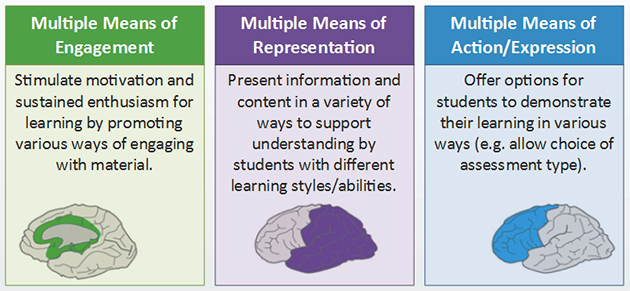
Also from my side, I find that having a diversified team of instructional designers to create learning material for international learners can help in identifying cultural based learning differences, and if a material needs to be translated, I suggest having a local instructional designer from the targeted culture to help in translating the unspoken content.
I suggest you take a look at Pamela’s article UDL Is the Key to Culturally Inclusive Instructional Design for more on how UDL principles work to create culturally inclusive learning material.
On the other hand, I wonder if you have a relevant experience to share; I would love to hear your point of view.
Featured image by Gerd Altmann from Pixabay
]]>One of the organizations that got me thinking is Mozilla Foundation, they believe that the Internet is a global public resource that must remain open and accessible to all. An initiative they have called web literacy is a great manifestation of how can instructional designers give back to the global society. With tools such as the internet our social impact can cross geographical borders, we became global citizen, a topic that deserves to be elaborate more about in another post. Mozilla’s objective is to bring equitable access to the internet for more people, there solution was to curate a curriculum that covers web literacy skills and 21st century skills. They were able to offer this open source of learning by collaborating with a diverse community of educators, practitioners, and technologists. As instructional designers holding knowledge in both learning design and educational technological tools we are of great value to such initiatives.
Another inspiring example I found to have a great impact on the community of education is the work of Dr. David Wiley. He is the author of the 5R framework that many colleges and universities use to frame their open education initiatives. He advocates for open education and the use of open educational resources.
“If I have the means, I have the social responsibility to employ them”
– Terry Brooks
Both Mozilla and Dr. Wiley are examples of how being a member of the education and learning community can have a positive impact on the local and global societies around us. Personally, I strongly believe in the power of education and knowledge and how it can build capable and skilled people who would form empowered communities. Also, I think that no matter how small our efforts to give back may seem to us the impact it would have is not! This impact would even be bigger if we managed to collaborate as instructional designers and education technologists to reach an objective of providing access to free or affordable education to more people around the world.
I would like to hear your thoughts on what is our social responsibility as instructional designers towards global and local communities? and what ideas or experiences you can share?
Featured image by “My life through a lens” on Unsplash
]]>Self-identity is a complex concept that has been defined in various ways and theories. An article that I have read recently on digital identities and “real” selves, made me think of how will I answer this question while being real to myself. The truth is, we tend to have different identities that suit every situation life puts us in. I am not trying to say that we are living fake identities, but as humans we develop complex personalities that are affected by how we see the world around us, how we see ourselves, and how we want people to perceive us. A quote I relate to on this topic is by sociologist Charles Cooley that says: “I am not what I think I am. I am not what you think I am. I am what I think you think I am”. A Short movie written and directed by Kalhil Adam called “Identity” is a great visual representation of the concept.
Who am I as an instructional designer today won’t be the same a year from now
Another reason I find answering the question of who am I as an instructional designer to be challenging is that the answer is going to change over time. Who am I as an instructional designer today won’t be the same a year from now, we change along with our skills and experiences. Therefore, I wanted to find an answer that would be fair, authentic, and perpetual. This is when I realized, that the reasons I chose to pursue instructional design overall is the answer I am looking for.
Why I chose to study and pursue instructional design (ID) shapes who am I as an instructional designer and lays the foundation of my ID practice. I selected ID because it evolves around development, learning, research, and diversity. Development is core to me, thus in my practice I would ensure that I am always working with my clients to develop their employees, students, and educational products. Learning in my ID work does not only apply to my contribution to people’s learning, but also to my willingness to spend time to learn about the clients’ business, background, and environment. Research is of importance in my practice as it helps me better understand the clients’ needs, and ensure that I am providing them with best practices and approach. Diversity is a value I seek in my work from working in diversified environments, projects, and industries, to the representation of diversity in the projects I produce. Making it short, my answer to who am I as an instructional designer is, I am a keen instructional designer who can help you build diversified learning experiences based on extensive research to help you develop your team and business.
This is me as an instructional designer. My question for you is, who are you as an instructional designer?
Would love to hear your thoughts.
Featured photo by Carson Arias on Unsplash
]]>